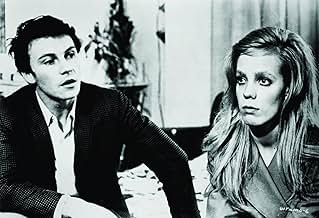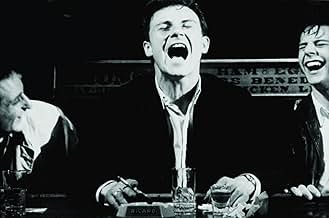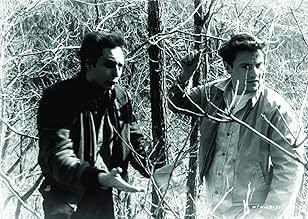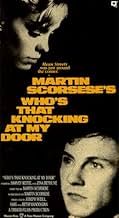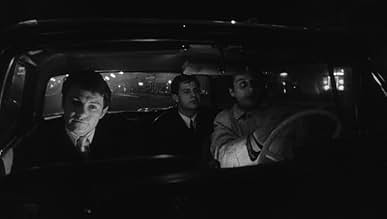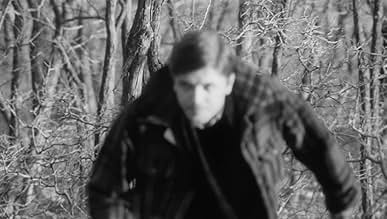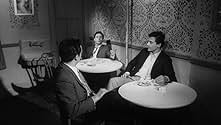VALUTAZIONE IMDb
6,5/10
10.581
LA TUA VALUTAZIONE
Un giovane si scontra con il fatto che la sua ragazza è stata violentata.Un giovane si scontra con il fatto che la sua ragazza è stata violentata.Un giovane si scontra con il fatto che la sua ragazza è stata violentata.
- Regia
- Sceneggiatura
- Star
- Premi
- 1 candidatura in totale
Anne Collette
- Girl in Dream
- (as Ann Collette)
Philip Carlson
- Boy in Copake
- (as Phil Carlson)
Marrissa Joffre
- Girl at Party
- (as Marrisa Joffrey)
Victor Magnotta
- Boy in Fight
- (as Vic Magnotta)
Thomas Aiello
- Minor Role
- (non citato nei titoli originali)
Recensioni in evidenza
This is a hard movie to review because it's essentially an amalgam of several different shorter student films, and some work better than others.
That said, at the crux of "Who's That Knocking at My Door" (the final mass-released version) is a complex character-study laden with Catholic guilt and burdened by all the inherent stigmas and traditions of growing up Italian-American.
Obviously Scorsece knew his source material very well. More than half of the players and virtually all the locations come straight from his own life. What's really cool about the film, though, is how honestly he portrays these sociological nuances. He doesn't tell you Keitel's character's views and attitudes are good or bad, they just "are" --- and it's obvious how the character developed them from a peek into his everyday world.
This bracing honesty is the most appealing thing about the film, along with some drop-dead gorgeous camera work and editing featured here. The first scene where Keitel meets Bethune on the ferry has got to be one of the most imaginatively-shot and enthrallingly staged boy-meets-girl moments on celluloid. Throughout the film, Scorcese overlays soundless scenes from the past and future, creating interesting juxtapositions, always engaging and challenging your perceptions.
With a lot of debuts there are missteps. I don't think that fairly characterizes this movie however. There are definitely parts that drag and don't work well but seen in the context of a shorter film, they would have been more effective. As they're all blended together here, the pacing sometimes suffers.
It's hard to imagine any of the fans of Scorsece's later works, which rely so heavily on hyper-real camera-work and tightly-structured story lines, to have the patience for "Who's That Knocking." But for those who really enjoy the thoughtfulness, subversiveness, and subtext of Scorcese's films, it's a treat to see their origins so prominently displayed.
That said, at the crux of "Who's That Knocking at My Door" (the final mass-released version) is a complex character-study laden with Catholic guilt and burdened by all the inherent stigmas and traditions of growing up Italian-American.
Obviously Scorsece knew his source material very well. More than half of the players and virtually all the locations come straight from his own life. What's really cool about the film, though, is how honestly he portrays these sociological nuances. He doesn't tell you Keitel's character's views and attitudes are good or bad, they just "are" --- and it's obvious how the character developed them from a peek into his everyday world.
This bracing honesty is the most appealing thing about the film, along with some drop-dead gorgeous camera work and editing featured here. The first scene where Keitel meets Bethune on the ferry has got to be one of the most imaginatively-shot and enthrallingly staged boy-meets-girl moments on celluloid. Throughout the film, Scorcese overlays soundless scenes from the past and future, creating interesting juxtapositions, always engaging and challenging your perceptions.
With a lot of debuts there are missteps. I don't think that fairly characterizes this movie however. There are definitely parts that drag and don't work well but seen in the context of a shorter film, they would have been more effective. As they're all blended together here, the pacing sometimes suffers.
It's hard to imagine any of the fans of Scorsece's later works, which rely so heavily on hyper-real camera-work and tightly-structured story lines, to have the patience for "Who's That Knocking." But for those who really enjoy the thoughtfulness, subversiveness, and subtext of Scorcese's films, it's a treat to see their origins so prominently displayed.
Here is Martin Scorsese's first feature film, and already, at a mere 25 years old in 1967, it is clear this young man had the determination and eye for visceral images, solid acting and a great ear for soundtracks. A rather raw and unpolished work, Who's That Knocking at My Door works in other ways such as the professionally-done editing by the great Thelma Schoonmaker, another future Scorsese collaborator. In the lead role is a very young Harvey Keitel, who plays the role of a young New York Italian very similar to the nature and style of Martin Scorsese himself. Clearly, there was a special bond between these two that continued for years.
The plot, while at times veering wildly off track, focuses on a young couple attempting to overcome a difficult instance in the past that still looms over the future. With numerous Catholic images and references, this is one of the more explicitly religious of Scorsese's work but there is still a definitive drive behind everything. It is certainly worth watching for anyone who is interested in making their own film as well as any fan of Scorsese eager to know how he got to where he is today. Not always great, sometimes very powerful, this film still remains a strong piece of work that encompasses much of future themes Scorsese would come back to: Catholic guilt, relationships between street friends and the difficulties of romance.
The plot, while at times veering wildly off track, focuses on a young couple attempting to overcome a difficult instance in the past that still looms over the future. With numerous Catholic images and references, this is one of the more explicitly religious of Scorsese's work but there is still a definitive drive behind everything. It is certainly worth watching for anyone who is interested in making their own film as well as any fan of Scorsese eager to know how he got to where he is today. Not always great, sometimes very powerful, this film still remains a strong piece of work that encompasses much of future themes Scorsese would come back to: Catholic guilt, relationships between street friends and the difficulties of romance.
I am an unabashed admirer of Martin Scorsese's work, and his first feature did not disappoint. Filmed on practically no budget, this movie uses a nonlinear approach to storytelling that predates "Pulp Fiction" by some 25 years. One can also see a precursor of Scorsese's later cinematic technique, and just a hint of his nightmare-world view of New York that is so apparent in his later works "Taxi Driver," "After Hours" and "Bringing Out the Dead." Scorsese's trademarkfinding the perfect piece of contemporary music for each sceneis also quite apparent here.
As the traditionally-minded J.R., the young Keitel turns in a riveting performance in his first film appearance, as a working-class New Yorker torn between his cultural norms and his love for an intelligent, independent woman. Bethune is today better known as a dancer and humanitarian, but as "The Girl" she is utterly convincing and nothing short of ravishing, with a presence both ethereal and self-assuredly erotic. The meeting of the two characters is really a meeting of the traditional with the modern--something much on people's minds in 1968 when this film was made. It's interesting that in some places this movie was retitled "I Call First"the gist of the conflict between the lovers. J.R. receives a piece of information about The Girl's past, one that he cannot put into perspective given his macho set of social norms. Scorsese throws in a dash of the Catholic morality and male-centeredness current at the time, and we have a memorable exploration of the place of culture and religion in determining who and how much we love.
If you're a Scorsese fan, this film is a must-rent. If you're uninitiated, see a couple of his later films first, then go back to this one for a look at two future giantsScorsese and Keitelon their first project, as well as an excellent performance by Bethune, who should certainly have had more featured roles following this one.
As the traditionally-minded J.R., the young Keitel turns in a riveting performance in his first film appearance, as a working-class New Yorker torn between his cultural norms and his love for an intelligent, independent woman. Bethune is today better known as a dancer and humanitarian, but as "The Girl" she is utterly convincing and nothing short of ravishing, with a presence both ethereal and self-assuredly erotic. The meeting of the two characters is really a meeting of the traditional with the modern--something much on people's minds in 1968 when this film was made. It's interesting that in some places this movie was retitled "I Call First"the gist of the conflict between the lovers. J.R. receives a piece of information about The Girl's past, one that he cannot put into perspective given his macho set of social norms. Scorsese throws in a dash of the Catholic morality and male-centeredness current at the time, and we have a memorable exploration of the place of culture and religion in determining who and how much we love.
If you're a Scorsese fan, this film is a must-rent. If you're uninitiated, see a couple of his later films first, then go back to this one for a look at two future giantsScorsese and Keitelon their first project, as well as an excellent performance by Bethune, who should certainly have had more featured roles following this one.
Filmed over years apparently, this early M. Scorsese New York tale involving young dudes being typically out of it is interesting in the scenes with Keitel and the girl (Z. Bethune), but the buddy scenes tend to drag on and semi-bore. A 5 out of 10. Best performance = Zena Bethune.
Harvey Keitel has always been interesting and believable and it's great to see him in a lead (pre-MEAN STREETS) and Ms. Bethune is very touching and human. All Scorsese fans should track this down even though it's not that great. The DVD has a semi-commentary from Marty which is unusual! It comes in the recent DVD set of Martin Scorsese and worth a look! Harry Northrup has a small role (MEAN STREETS, TAXI DRIVER).
Harvey Keitel has always been interesting and believable and it's great to see him in a lead (pre-MEAN STREETS) and Ms. Bethune is very touching and human. All Scorsese fans should track this down even though it's not that great. The DVD has a semi-commentary from Marty which is unusual! It comes in the recent DVD set of Martin Scorsese and worth a look! Harry Northrup has a small role (MEAN STREETS, TAXI DRIVER).
WHO'S THAT KNOCKING AT MY DOOR? (3+ outta 5 stars)
Early feature film by the now-legendary Martin Scorsese... it sort of sprawls all over the place... melding all kinds of weird artsy gimmicks and camera styles... but the central relationship between Harvey Keitel and the pretty blonde girl he meets and falls in love with on the Staten Island Ferry (Zina Bethune) keeps the movie's momentum going, even when it veers off into interesting but sometimes pointless tangents. If you thought Quentin Tarantino invented the character of the movie geek who seeks to impress the woman of his dreams by rambling on with movie trivia... well, this movie will set you straight. You will also see hints of Scorsese's later masterpieces ("Mean Streets", "Goodfellas") in embryonic form. I hadn't seen this movie in years... but just saw the new DVD version and was amazed at how good it was.
Early feature film by the now-legendary Martin Scorsese... it sort of sprawls all over the place... melding all kinds of weird artsy gimmicks and camera styles... but the central relationship between Harvey Keitel and the pretty blonde girl he meets and falls in love with on the Staten Island Ferry (Zina Bethune) keeps the movie's momentum going, even when it veers off into interesting but sometimes pointless tangents. If you thought Quentin Tarantino invented the character of the movie geek who seeks to impress the woman of his dreams by rambling on with movie trivia... well, this movie will set you straight. You will also see hints of Scorsese's later masterpieces ("Mean Streets", "Goodfellas") in embryonic form. I hadn't seen this movie in years... but just saw the new DVD version and was amazed at how good it was.
What Scorsese Film Ranks Highest on IMDb?
What Scorsese Film Ranks Highest on IMDb?
Cinema legend Martin Scorsese has directed some of the most acclaimed films of all time. See how IMDb users rank all of his feature films as director.
Lo sapevi?
- QuizIn order to get distribution for his film, Martin Scorsese was told to add nude scenes so it could be promoted as a "sexploitation" movie. He thus shot the fantasy scene showing J.R. imagining encounters with prostitutes.
- BlooperMartin Scorsese utilizes the black and white nature of film to hide the lack of time and day continuity in some scenes.
- Curiosità sui creditiThere is a big "Thanks to the County and City of New York" in the end credits.
- Versioni alternativeEarly versions of this film were screened without the erotic fantasy scene.
- ConnessioniFeatured in A Decade Under the Influence (2003)
- Colonne sonoreJenny Take a Ride
(uncredited)
Written by Bob Crewe, Enotris Johnson, and Little Richard
Performed by Mitch Ryder & The Detroit Wheels
I più visti
Accedi per valutare e creare un elenco di titoli salvati per ottenere consigli personalizzati
Dettagli
- Data di uscita
- Paese di origine
- Siti ufficiali
- Lingua
- Celebre anche come
- Who's That Knocking at My Door
- Luoghi delle riprese
- Amsterdam, Olanda Settentrionale, Paesi Bassi(as New York, only interior, scenes with nudity)
- Aziende produttrici
- Vedi altri crediti dell’azienda su IMDbPro
Botteghino
- Budget
- 75.000 USD (previsto)
- Lordo in tutto il mondo
- 16.085 USD
- Tempo di esecuzione1 ora 30 minuti
- Colore
- Mix di suoni
- Proporzioni
- 1.85 : 1
Contribuisci a questa pagina
Suggerisci una modifica o aggiungi i contenuti mancanti

Divario superiore
By what name was Chi sta bussando alla mia porta? (1967) officially released in India in Hindi?
Rispondi
